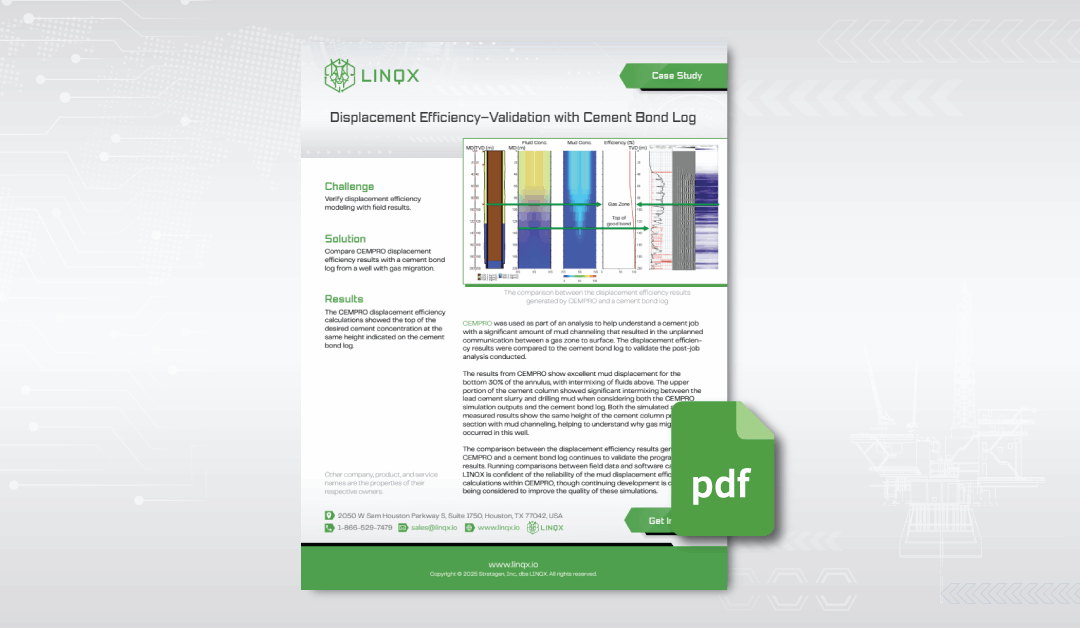Not every cementing failure is obvious at first. Some, like this case, unfold quietly—until gas begins migrating to the surface and questions arise about what happened in the annulus.
This post outlines the technical evaluation of a cement job that initially appeared successful but ultimately failed to provide effective zonal isolation. By combining field data from a cement bond log (CBL) with post-job displacement efficiency modeling, engineers traced the failure back to a root cause: ineffective mud displacement in the upper annulus.
Surface Success, Subsurface Failure
The cementing operation targeted a well section intersecting a known gas-bearing formation. The design included standard elements: a lead slurry to aid mud removal, a denser tail slurry to seal the interval, and spacer fluids between cement and drilling mud.
On surface, the operation was executed without incident. Pump rates, pressures, and volumes were all within expected ranges. But in the days that followed, gas was detected at surface, signaling a failure in annular isolation.
Defining the Top of Effective Bond
The cement bond log provided acoustic data to assess cement presence and quality behind casing. Key indicators emerged:
- Good bond was detected in the lower third of the cemented interval, indicating sufficient cement placement and bonding with casing and formation.
- A distinct top-of-bond was observed—above this, amplitude readings suggested poor or absent cement bonding.
- There were signs of possible mud channeling in the upper annulus, likely where mud remained trapped or intermixed with slurry.
The bond log alone hinted at an uneven displacement process—but to validate this and understand the flow dynamics, a post-job simulation was needed.
Simulating Fluid Displacement in the Annulus
Using the original job parameters—fluid densities, rheology, pump schedule, casing and hole geometry—a displacement efficiency simulation was conducted to recreate the downhole fluid behavior.
The model predicted:
- High displacement efficiency (≥90%) in the lower annulus, where flow velocities and annular geometry were favorable for mud removal.
- Increasing intermixing between lead slurry and drilling mud in the upper annulus, where reduced flow velocities and eccentricity contributed to incomplete displacement.
- A top of high cement concentration at the same depth where the CBL indicated the end of effective bond.
This correlation validated the hypothesis: intermixing and incomplete displacement in the upper annular section prevented full mud removal, resulting in a diluted slurry and ultimately poor cement bonding. The residual mud created preferential flow paths that allowed gas migration to surface.
Key Takeaways
Displacement efficiency is depth-dependent
Effective mud removal is influenced by flow regime, annular clearance, and casing eccentricity—especially in large-diameter or deviated sections.
Fluid intermixing impacts bond quality
When cement slurries mix with residual mud, slurry rheology, set time, and compressive strength can be compromised, leading to poor bonding.
CBL + modeling = stronger validation
Field data from cement bond logs, when paired with post-job simulations, provide a robust diagnostic for evaluating cement job performance and identifying causes of failure.
Gas migration is often a symptom, not the root issue
The true cause typically lies in fluid placement problems—highlighting the need for better upfront modeling and post-job analysis.
For a deeper dive into displacement efficiency and its impact on cement bond, see our full technical case study on Displacement Efficiency—Validation with Cement Bond Log.
From Field Case to Prevention
This case underscores the importance of integrated cementing diagnostics. By aligning simulation results with bond log data, engineers not only confirmed the failure mechanism but also gained insight to improve future cementing designs.
If you’re involved in well construction and encounter issues like:
- Poor bond log results
- Suspected mud channeling
- Gas migration to surface
- Uncertainty about fluid placement effectiveness
a displacement efficiency modeling tool like CEMPRO can provide clarity. In this case, the simulation results closely matched the cement bond log, confirming the root cause of failure and demonstrating the value of modeling in both post-job evaluation and design improvement.
To learn more about how CEMPRO supports better cementing decisions, reach out to our team.

